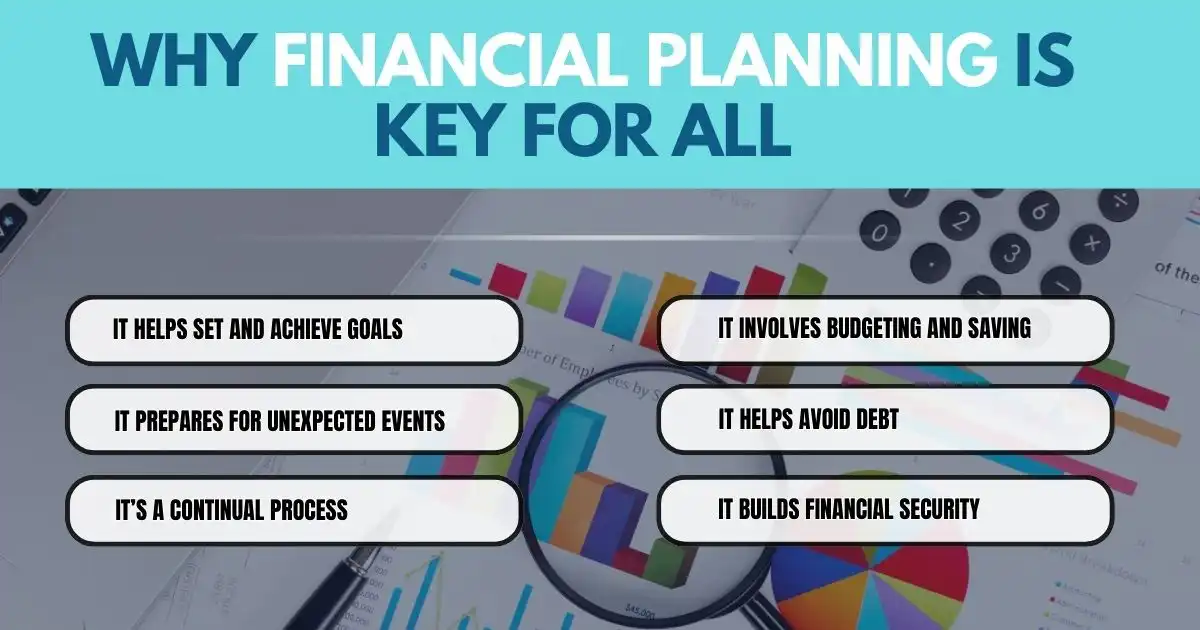We all want to be that person who’s organized with money, especially when it comes to saving for the future.
But let’s be real—not everyone has it all figured out, and we could all use some help.
Though Financial Literacy Month is in April, every day is an opportunity to learn different topics to make understanding money easier and hopefully improve everyone’s life.
What Is Financial Planning?
Financial planning is like a roadmap for your money. It helps you set goals for your finances, manage income and spending, pay off debt, and prepare for unexpected events.
A financial plan shows where you stand financially and the steps to reach your goals. Investment planning is part of this, helping you build a secure future by looking at your income, savings, and expenses. You can make a plan on your own or with a financial expert.
Why Financial Planning is Beneficial for Everyone

Financial planning is not just for those with lots of money; anyone can benefit from it. It helps people and businesses prepare for future goals and unexpected challenges.
It Helps Set and Achieve Goals
Financial planning makes it easier to reach specific goals, such as saving for college, buying a house, or retiring comfortably. By setting clear goals, individuals can create a step-by-step plan to guide them toward those objectives.
It Prepares for Unexpected Events
A solid financial plan includes preparations for unexpected situations, like medical emergencies or job loss. Having an emergency fund, for instance, can help reduce stress during tough times.
It’s a Continual Process
Financial planning isn’t a one-time task. It’s an ongoing process that adapts to life events, income changes, and new goals. Regularly reviewing and updating a financial plan keeps it relevant and useful.
It Involves Budgeting and Saving
A financial plan includes budgeting, which means understanding income and expenses. It also involves saving for future needs, making achieving both short-term and long-term goals easier.
It Helps Avoid Debt
Effective financial planning helps manage money better, reducing reliance on debt, like credit cards or loans, for everyday expenses. A good plan includes strategies to pay off debt and avoid unnecessary borrowing.
It Builds Financial Security
By following a financial plan, individuals and businesses can build financial security, ensuring they have enough money for future needs and feel more stable. It’s about being prepared and confident, not just accumulating wealth.
5 Steps in Financial Planning
Building a business’s financial plan is about setting clear goals, understanding potential costs, and preparing for growth and unexpected challenges. Here’s a breakdown of the main steps:

Step 1. Review Your Strategic Plan
Start by looking at your business’s overall goals. Ask important questions like:
- Are we planning to expand or add new locations?
- Will we need to hire more staff?
- Is there a need for additional equipment or other resources?
- How might these plans affect our cash flow and expenses?
- Will we need extra financing? How much?
Step 2. Develop Financial Projections
Financial projections are estimates of future income and expenses. These projections can be monthly or weekly, depending on the business’s needs. Here’s how it works:
- Income Projections – Estimate how much money the business will bring in, often based on expected sales.
- Expense Projections – Consider regular costs like supplies, rent, and labor.
- Scenario Planning – Create a few different versions of projections. For instance, make an optimistic plan (best-case), a likely plan, and a pessimistic plan (worst-case) to see how each scenario could affect the business.
To make these projections, refer to key documents like a projected profit and loss statement and a balance sheet. These help show the business’s financial health over time.
Step 3. Arrange Financing and Plan for Growth
Based on the financial projections, determine if you’ll need financing to reach the business goals. Prepare these projections to share with investors or lenders who can help secure funds for growth.
It’s also essential to keep emergency money sources available. This could be in the form of credit or a cash reserve. Having these reserves ready makes it easier to manage surprises and helps keep the business stable during financial shifts.
Step 4. Monitor Progress
Financial planning isn’t a one-time task; it’s ongoing. Throughout the year, check how actual income and expenses compare to your projections. If the numbers are off track, adjust the plan. Monitoring helps identify financial problems early and highlights areas for smart growth, keeping the business flexible and prepared.
Step 5. Get Help and Use Financial Tools
For some businesses, having expert financial guidance can make a big difference. This might mean hiring financial planning services or using special software. Financial tools, like budgeting software or financial planning apps, can help make the process more efficient and accurate.
When to Make a Financial Plan
There’s never a wrong time to start a financial plan, but certain life events make it especially important to create one.

Having Children – Raising kids means planning for both short-term costs, like childcare, and long-term goals, like saving for college. A financial plan can help parents make a path to reach these goals. Studies also show that parents with strong money management skills set a good example for their kids.
Sudden Increase in Income or Assets – Getting a big pay raise, a new job, or unexpected money can change your lifestyle. A financial plan helps avoid “lifestyle creep,” which is when higher spending habits grow along with income, making it harder to save.
Serious Illness – Health issues can be tough and add new, ongoing costs. A financial plan helps you stay on track to meet financial goals even with these challenges. Studies show that having a financial plan can even improve well-being and life expectancy.
Retirement – When you retire, a financial plan helps you stretch your savings for as long as possible. Research shows that a well-thought-out savings plan can make retirement funds last several years longer.
Your Roadmap to Success
Financial planning isn’t just a luxury; it’s a necessity for everyone. Think of it as building a sturdy bridge to your future, allowing you to cross the tricky waters of unexpected expenses and goals. If you’re saving for a child’s education or preparing for retirement, having a clear plan keeps you grounded. Don’t let life’s curveballs catch you off guard—plan for them!
Remember, a penny saved is a penny earned, and budgeting is the compass that keeps your spending on track. Start today, because the best time to plant a tree was yesterday; the second-best time is now. No matter your income level, the path to financial security is open to all.
Take that first step, review your goals, and don’t hesitate to seek help when needed. Your future self will thank you!
FAQs
What is a critical aspect of financial planning?
A critical aspect of financial planning involves assessing your current financial situation, setting realistic goals, and creating a roadmap to achieve those goals. This includes budgeting, saving, and investing wisely to ensure long-term financial security.
Which best describes the role of financial planning?
The role of financial planning is to provide a structured approach to managing finances. It helps individuals and businesses set clear financial goals, allocate resources effectively, and prepare for unexpected expenses, ensuring a stable financial future.
What does a well-designed, successful financial plan include?
A well-designed, successful financial plan includes components such as a detailed budget, savings goals, investment strategies, debt management, and an emergency fund. It also incorporates regular reviews and adjustments to adapt to changing circumstances.
Functions of financial management do not include?
Functions of financial management do not include purely administrative tasks or bookkeeping. Instead, it focuses on strategic planning, financial analysis, investment decisions, and risk management to maximize the organization’s financial health.
